Sony Alpha DSLR-A100 review with DT 18-70mm f3.5~5.6
-
-
Written by Gordon Laing
Sony Alpha DSLR-A100 wide-angle uniformity comparison using DT 18-70mm
Sony Alpha A100 results …
Outdoor / Resolution / Noise / Noise 2 / Corner sharpness / Fringe & macro / Geometry / Vignetting
| Support this site by shopping via these links |
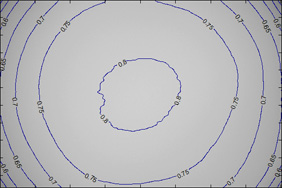 |
To measure and compare the Sony DSLR-A100’s lens vignetting and light fall-off we photographed a white target with a highly diffused custom filter using it and a number of rival models. Here are the results for each camera with their bundled lenses set to their widest focal lengths with the apertures wide open and the focus set to infinity. The images were analysed with Imatest and the full areas presented here at a reduced resolution. Bigger percentages are better. |
|
The image above was taken with the Sony Alpha DSLR-A100 using the DT 18-70mm lens at 18mm f3.5. Here the light falls off in the corners to an average of 63.3% of the center measurement, which is similar to average DSLR kit lenses, but below that of all-in-one cameras like Sony’s own R1. The result is also measurably lower than that of the Konica Minolta 5D which may seem surprising since both cameras were essentially using the same optics. It should always be remembered though different copies of the same lens can deliver varying results. Additionally when comparing these two results, remember the bodies were also different models, each employing two different sensors and image processors – and as explained in our testing notes, we acknowledge we’re testing both the body and lens as a complete system. Ultimately though, the important thing is the lens tested performed averagely against other digital SLR kit lenses in terms of uniformity at its wide-angle end. |
Canon EOS-350D |
Konica Minolta 5D |
Sony Cyber-shot DSC-R1 | ||
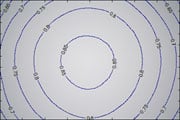 | 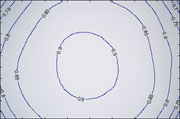 | 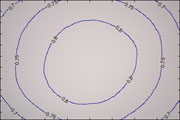 | ||
|
18-55mm EF-S at 18mm f3.5 Mean corner fall-off: 68.8% |
18-70mm DT at 18mm f3.5 Mean corner fall-off: 73.5% |
14.3-71.5mm at 14.3mm f2.8 Mean corner fall-off: 79.2% |
Sony Alpha DSLR-A100 telephoto uniformity comparison using DT 18-70mm
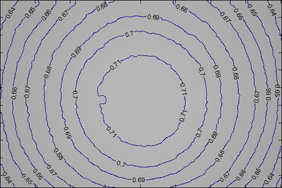 |
To measure and compare the Sony DSLR-A100’s lens vignetting and light fall-off we photographed a white target with a highly diffused custom filter using it and a number of rival models. Here are the results for each camera with their bundled lenses set to their longest focal lengths with the apertures wide open and the focus set to infinity. The images were analysed with Imatest and the full areas presented here at a reduced resolution. Bigger percentages are better. |
The image above was taken with the Sony Alpha DSLR-A100 using the DT 18-70mm lens at 70mm f5.6. Here the light falls off in the corners to an average of 87.7% of the center measurement, which is better than the Canon 350D and roughly the same as the Sony R1. The result is also close to that previously measured for the Konica Minolta 5D with its kit DT 18-70mm lens. In theory the Sony DT and Konica Minolta DT lenses should score the same since they are essentially identical models, but as mentioned above, different copies of the same lens can often deliver different results. When comparing these results, it should also be remembered the bodies were different models, each employing two different sensors and image processors – and as explained in our testing notes, we acknowledge we’re testing both the body and lens as a complete system. Ultimately though, the important thing is the lens tested performed better than most digital SLR kit lenses in terms of uniformity at its telephoto end. |
Canon EOS-350D |
Konica Minolta 5D |
Sony Cyber-shot DSC-R1 | ||
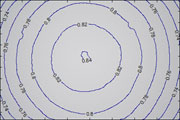 | 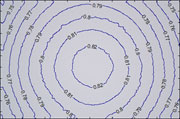 | 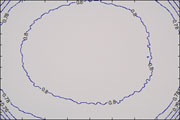 | ||
|
18-55mm EF-S at 55mm f5.6 Mean corner fall-off: 83.8% |
18-70mm DT at 70mm f5.6 Mean corner fall-off: 90.1% |
14.3-71.5mm at 71.5mm f4.8 Mean corner fall-off: 87.2% |




